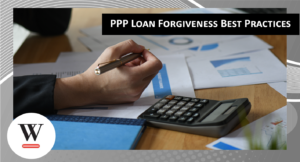Rules and definitions — timetable — requirements — banking and accounting recommendations — plus, better bookkeeping hints and instructions
Greetings, clients and friends,
We hope that you are staying safe and not taking unnecessary risks. Many of you participated in our webinars and we thank you for that. Our goal was to provide you with insight into the new CARE Act programs. This article provides further insight into the Payroll Protection Program (PPP) and best practices.
By now many of you applied for a PPP loan with your financial institution. If you haven’t, contact your bank and see if they participate. If they do, stop reading and request an application, then call our office. Our priority is making sure you can apply and receive PPP funds. Over the past week, we assisted many clients – assembling proper documentation, calculating loan amounts, and making introductions to participating lenders.
Recall from our webinars that this program starts off as a loan, it will be up to you to determine how much will be forgiven. You need to keep detailed accounting records and documentation for the duration of the eight weeks in which you spend the proceeds.
The eight-week window begins once your loan is funded. You are required to spend a minimum of 75% of the proceeds on payroll costs (salaries/wages), health insurance premiums, retirement benefits and state employer taxes (here in PA that is unemployment compensation tax). You want to make sure you’re tracking all these items in your payroll system. For those not using a payroll system, we recommend obtaining one now. Our firm offers this service, and there are many others – ADP, Gusto, etc. To qualify for forgiveness your business needs to accurately account for its payroll costs, including timing.You also need to determine your Full Time Equivalent Employee (FTEs) for the period of 2/15/2019 through 6/30/2019 or 1/1/2020 through 2/29/2020 (if you were not in business in 2019). The SBA doesn’t care about the names for the above period they just want to see the same number of names being paid in 2020.
What about the other 25% portion of the loan? That can be spent on non-payroll items such as rent, utilities, interest on mortgages (real or personal property) incurred prior to 2/15/2020. For those using an accounting system (QuickBooks, Quicken, Xero, etc.) you will have a leg up in this race. For those not using an accounting system this might be a good time to start. In QuickBooks for example you can use Class tracking and create a PPP class. You can then track the PPP transactions used during the 8-week period.
Another approach picking up steam the last few days is setting up a new bank account specifically for the PPP proceeds. Using a separate bank account, you can easily track the spending from the PPP loan and the bank statement activity will add further evidence. Remember, the goal is to use the funds for approved purposes, if so, SBA will forgive the loan.
For our sole proprietors or partners in a partnership (LLC or other) in the audience reading this and scratching your head and asking “How will I document payroll costs when I haven’t seen a “paycheck” in years?” don’t be alarmed – this section is for you. Your net profit on your 2019 Schedule C or K-1 boxes 1, 4A and 14 are your own “payroll” in this program. We use that in calculating the average total payroll.
Let’s use following example – in 2019, assume your amount was $75,000 – that would equate to $1,442 per weekly compensation period ($75k/52 weeks). When you receive your PPP proceeds (hope is alive at the time of writing this article one of our clients received PPP funds), we recommend you pay yourself a weekly draw during the 8 weeks spending period. That will mean writing a check from your business account to yourself and depositing it into your personal account. On the check memo line write “weekly draw PPP proceeds.” When the check clears, make a copy of the cancelled check (front and back) and file with documentation for submitting to the PPP lending bank after the 8-week payment period.All of which leads us to our next 3 tips – documentation, documentation, and documentation. Make sure to document every PPP dollar with copies of payroll checks (if using our payroll service, we will provide this for you), electronic receipts, timecards, payroll reports. For health insurance premiums, make a copy of the invoice and the check or EFT to prove the date paid and amount. Ditto for retirement plan contributions.
For rent, loan interest and utilities our recommendation is use the actual checks or ACH payments to document amounts and dates along with your monthly invoices. In addition, dig up a copy of your rental agreement and your bank loan agreement (make sure those agreements were entered prior to Feb. 15, 2020). Think of the bank conducting an IRS audit – you knew the government would be involved in this somehow – and the auditor is grumpy, apprehensive and cynical (a true nightmare).
In this electronic age, why not create a PPP expense folder on your computer/server/cloud network and save all your documents there. We suggest daily updates/monitoring.
Rest assured we are staying alert to further guidance from the SBA about the forgiveness calculation. If the rules change, we will notify you. Our goal is to make sure our eligible clients participate in ALL available programs. Keep a lookout for future guidance from us. In the interim please be careful, and call or email us if you have any questions, 610-770-9236 or info@wernercpa.net.
Thank you for your interest and stay safe,
Kristofer M DePaolo, CPA | CEO
 Our important new webinar series will be discussing how to apply for loan forgiveness and the specific record keeping practices that will determine how businesses qualify for forgiveness of their loan. Register now.
Our important new webinar series will be discussing how to apply for loan forgiveness and the specific record keeping practices that will determine how businesses qualify for forgiveness of their loan. Register now.
 Werner & Co. CPAs is ready to help you understand and comply with requirements.
Werner & Co. CPAs is ready to help you understand and comply with requirements.